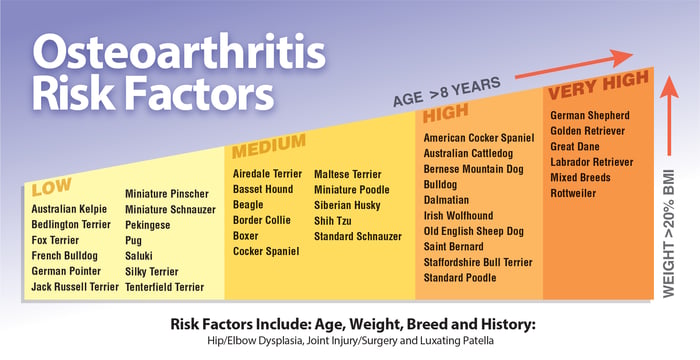Arthritis is a joint disease that affects people as well as dogs. Canine Osteoarthritis (OA) can be as painful for our fur-babies as it is for us. If you are new to the subject, you may wonder what are some of the most important dog arthritis signs? We have the answers and more.
The healthy joints of dogs and humans alike have a slippery tissue called cartilage that cushions the ends of the bones in the joints. With arthritis in dogs, cartilage breaks down, causing pain and swelling. As arthritis gets worse, bone spurs can form, or the cushion degrades enough to make it bone on bone, causing pain and further joint damage.

Some think the key symptom of a dog with arthritis is limping, but dogs are pretty good at hiding pain and may never limp. For some dogs, when this happens, your dog may simply become less active or show signs of stiffness when getting up. There may be visible signs of arthritis in your dog's legs. However, OA can be difficult to recognize and your dog may not show any signs of OA.
Osteoarthritis in dogs can be difficult to recognize and your dog may not show any signs.
That’s why it’s important to talk to your veterinarian today about keeping your dog active and youthful. The earlier you start the better chance you have of bringing out the puppy inside him.
Top 5 Risk Factors for Osteoarthritis
- Breed: Large dog breeds like Labs, Retrievers and Shepherds are more likely to develop OA at a young age. Small to medium-sized dogs can have OA as well but it may not be as prevalent.
- Age: Many think arthritis in older dogs is part of aging. While 80% of dogs will show signs of OA by age 8, some dogs show signs as early as the age of one year. And just like in humans, there are ways to help relieve the symptoms if your dog has arthritis.
- Weight: It’s important to know the optimal weight for your dog’s breed. Try to keep him close to that weight to minimize stress on his joints. The more they weigh, the harder it is on your dog's mobility.
- Health History and issues: Consider if your dog has joint issues such as hip dysplasia in dogs, knee problems or ligament injuries. If there has been an accident with your dog or if there has been a joint surgery. These are all health history issues that may contribute to arthritis in your dog.
- Mobility: Do you see your dog doing less? Do they have problems climbing stairs, or jumping up where they once jumped before? Do you need to help your dog get in the car?

Take the quiz and learn your dog's risk. It may not be aging that is causing them to do less. It may be the painful signs of arthritis taking over.
Arthritis in dogs symptoms
As we mentioned before, dogs are really good at hiding pain. Dogs live for us and are the most unselfish creatures on Earth. Dogs are people pleasers and they want us to be happy, so they will try to maintain a happy outlook on life even if they are in pain. So how can you tell if your dog has arthritis? Look for these signs your dog might have arthritis:
- Sometimes, there are no signs. Dogs are very good at hiding pain. You may not realize what they have been quietly telling you. Try taking this short quiz which gets to underlying conditions that may show your dog might be suffering.
- Decreased activity. Have you noticed your dog sleeping more? These are tell-tale (or tell-tail) signs of arthritis.
- More licking. Is your dog licking joint areas more? This includes licking of the paws or ankles, hind quarters.
- Behavior changes. Have you noticed your dog always loved eating their food, now, not so much? Or maybe they wanted to go for a car ride with you and they don't attempt to come with you? Sometimes the behavior change is small, such as indifference. Other times it can be bigger, such as growling or nipping at family members when you try to pet them or move them somehow. These are signs your dog could be suffering from arthritis.
Check out our more detailed blog about "How to Tell if Your Dog is in Pain" for a visual image and more signs to look for.
How to Help Dogs with arthritis at Home
Just as arthritis is painful for people, it is for dogs too. Unfortunately, dogs can’t talk to tell us if they are in pain. Be sure to pay attention to visible signs of slow movement and arthritis in your dog's legs, arthritis in the dog's knee and especially the potential of arthritis in the back or hind legs. All you can do is view their behavior. Based on the risk factors listed above, you can determine if your dog might be a risk. You can also take this short arthritis assessment to determine if your dog has arthritis. Once you have this valuable information, find out how to treat arthritis in dogs or take a look at some other ways to help:
- Prevent signs of arthritis before they start and combat the signs with a joint supplement created by Parnell, Glyde™ Mobility Chews. Glyde promotes joint health and cartilage development to help keep dogs and cats active and youthful, longer. Improvement can be seen in most dogs with regular dosage.
- Of course, make sure your dog is still active to help their joints work better. This includes regular walking and playing with your dog. A great opportunity to go to the dog park!
- Keep the weight down for your dog. The heavier the dog, the more pressure on their joints. Every bit helps to make them more comfortable.
- Massage therapy for a dog works just as well as it does for humans. You can do this yourself.
- Provide more cushions for your pets. This includes a fluffy bed, rugs on the floor to lie on and more. If they are on a hardwood floor most days, they will begin to feel less comfortable.
The bottom line is – what makes you more comfortable if your joints were aching? Most likely you would be taking some sort of supplement and trying to stay active with a good diet and exercise. You can do the same for your dog.
Finding a dog arthritis treatment is tough, requiring research and comparisons of ingredients. We suggest using the best joint supplement for dogs: Glyde™ Mobility Chews, the top veterinarian-recommended joint supplement for dogs! Because your dog is worth it.
We know how you feel: our dogs are not just like family – they ARE family!
Find out more about arthritis in dogs.




.png)

